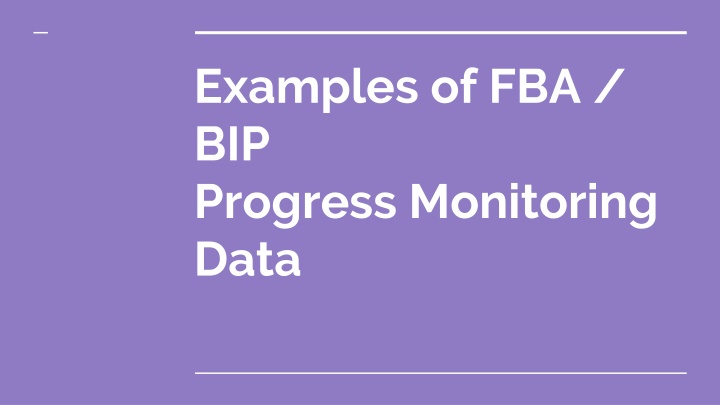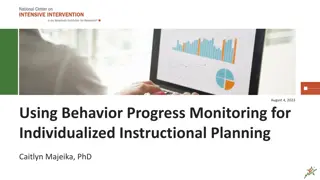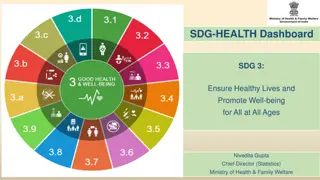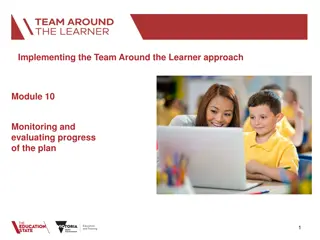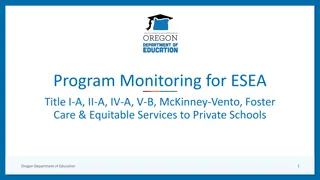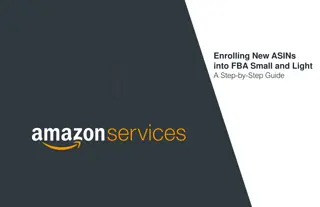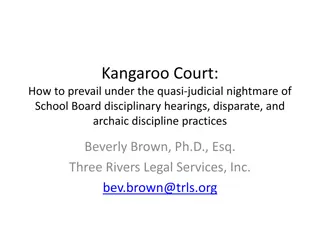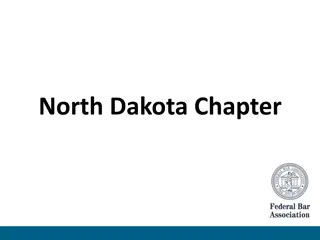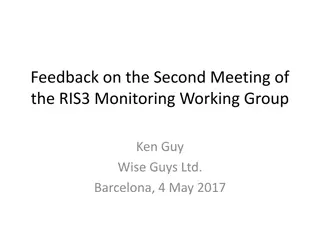Examples of FBA/BIP Progress Monitoring Data in School
In the context of school tools and FBA/BIP progress monitoring, essential guidelines and strategies are outlined for obtaining parental consent, identifying behaviors, collecting data, developing intervention plans, and monitoring progress effectively. The process involves thorough assessment, hypothesis statements, intervention strategies, crisis intervention procedures, and continuous evaluation to support students with persistent behavioral challenges.
Download Presentation

Please find below an Image/Link to download the presentation.
The content on the website is provided AS IS for your information and personal use only. It may not be sold, licensed, or shared on other websites without obtaining consent from the author.If you encounter any issues during the download, it is possible that the publisher has removed the file from their server.
You are allowed to download the files provided on this website for personal or commercial use, subject to the condition that they are used lawfully. All files are the property of their respective owners.
The content on the website is provided AS IS for your information and personal use only. It may not be sold, licensed, or shared on other websites without obtaining consent from the author.
E N D
Presentation Transcript
Examples of FBA / BIP Progress Monitoring Data
SchoolTools: Started to train the Social Workers Hope to have all FBA / BIPs uploaded for the end of the school year
FBA Must Haves: BIP Must Haves: Obtain parental consent A Behavioral Intervention Plan must include: Contact student s home district to request parental consent for completion of an FBA/BIP. District will ask if the parent has been notified District may ask for a written justification for an FBA Follow-up with district monthly to monitor status of consent Baseline measure of problem behavior, including frequency, duration, intensity and / or latency of targeted behaviors. Baseline measure must include data taken across activities, settings, people and times of day. Baseline will be used as a standard to evaluate intervention effectiveness. Identify the behavior in concrete terms (observable, measurable, concrete language) Expected behavioral changes (general outcome, long and short-term goals, maintenance & generalization) Behavior should be identified as a team (staff members working with student) Identify contextual factors that contribute to the behavior Collect data and gather information What methods will be used to measure and monitor progress toward goals (How will progress be recorded, at what frequency and by whom?) Identify sequence of events that reliably predict the behavior (Antecedent Events, Setting Events, Maintaining Consequences) Direct observation of student Collect Baseline Data. Observe student for at least 10-20 minutes across settings over at least three occasions or until data is stable. Data should address frequency, duration, latency, intensity. What form will data be collected, displayed and shared in? Create decision rules / criteria to determine if the BIP should be maintained, faded, modified or discontinued Complete interviews with teacher, parent and student (if appropriate) Complete motivation / behavior checklists Determine individual responsible for monitoring progress and integrity of implementation Review student records (academic, behavior, assessments, medical) Generate hypotheses statements Intervention Strategies Global Hypothesis: (Student) is a young person who enjoys . And is interested or successful in . Student might benefit from . Strategies to alter antecedent events and prevent the occurrence of behaviors Specific Hypothesis: When (describe context), this student (describe behavior) to (get / avoid consequences). This pattern is more likely to occur when Strategies to teach individual alternative and adaptive behaviors to the student Provision of consequences for targeted inappropriate behavior(s) Build a Competing Behavior Pathway to identify possible elements of a behavioral intervention plan Provision of alternative, acceptable behaviors Includes setting event, triggering antecedent, desired / problem / replacement behaviors and maintaining consequences Procedural steps for crisis intervention Replacement behavior should ultimately lead to desired behavior BIP must include the individual(s) responsible for each step Replacement behavior and problem behavior must have the same function Schedule to measure effectiveness of the interventions Replacement behavior must be easier or more motivating for the student Determine need for development of a Behavior Intervention Plan Must include frequency, duration and intensity of targeted behaviors at scheduled intervals Review following guidelines to determine next steps: The CSE or CPSE shall consider the development of a BIP, as such term is defined in 200.1(mmm) for a student with a disability when: (i) the student exhibits persistent behaviors that impede his or her learning or that of others, despite consistently implemented general school-wide or classroom-wide interventions; (ii) the student s behavior places the student or others at risk of harm or injury; (iii) the CSE or CPSE is considering more restrictive programs or placements as a result of the student s behavior. Section 201.3 If the manifestation team makes the determination that the behavior was a manifestation of the student s disability conduct and implement and /or modify the BIP. Progress Monitoring Implementation must include regular progress monitoring of frequency, duration and intensity of behavioral intervention BIP must specify how frequently progress should be monitored and reviewed A student s need for a behavioral intervention plan must be documented on the student s IEP and reviewed at least annually by the CSE / CPSE
Example of FBA data Including: Antecedent / Trigger Key Setting Duration Intensity Latency
Example of FBA data collection: Includes: Antecedent key Intensity Duration Latency
Progress Monitoring for the BIP Needs to reflect the strategies that are being addressed in the BIP
Example of FBA data Including: Antecedent / Trigger Key Setting Duration Intensity Latency
Example of BIP Progress Monitoring Data sheet
Example of Progress Monitoring for the BIP
Target Behavior: Time on Task When Zach is attending to a task by following directions and responding to his environment for 80% of the period. Aggression: Level 1: less than 2 minutes, low level head butting, kicking, hitting Aggression: Level 2: after 2 verbal / visual reminders Zack is standing on his desk, kicking, scratching, head banging others lasting 2-5 minutes, behavioral procedure is followed and he is able to return to task or alternative activity. Aggression: Level 3: When Zach is demonstrating level 2 behaviors, however increased aggression towards self, staff, and or students. Episode last 5-7 minutes behavioral procedure is followed and is able to return to original or alternative activity. Aggression: Level 4 When Zach is exhibiting above behaviors with an increase in aggression, has urinated / BM, destroying property and assistance is need to support Zach into the safety zone, Safety procedure is followed, however extra support staff is needed episode lasts over 7 minutes. L=Level TOT=Time On Task, Aggression Towards: S - self, ST student T- teacher Time / Aggression 8:30-9:00 Activity TOT Towards L 1 L 2 L 3 L4 T Comments 9:00-9:30 9:30-10:00 10:00-10:30 10:30-11:00 11:00- 11:30 11:30- 12:00 12:00-12:30 12:30- 1:00 1:00- 1:30 1:30-2:00 2:00- 2:30 Dismissal Trigger Key (T): S- Sensory W- wants something or access to a preferred activity C-Communication T Transition O-other TOT: ________/365, _____% Greeting Others with Prompts (Please mark Y or N for each trial)1- 2- 3- 4- 5- Greeting Others without Prompts 1- 2- 3- 4- 5-
